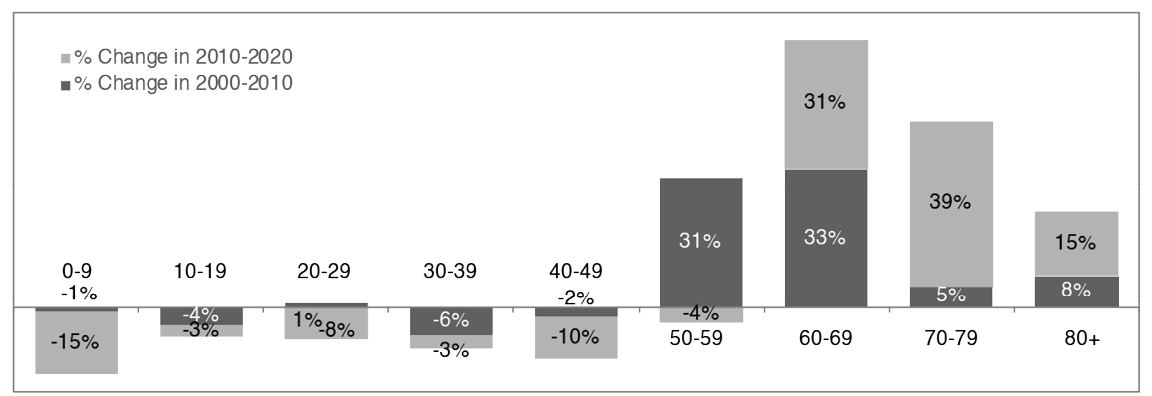Demographic Dynamics in Mississippi: Transition to an Aging Society
Mississippi is getting older, and the older population is growing rapidly. According to the latest Decennial Census data, population aging is a national trend; however, Mississippi’s aging speed exceeds the national average. Data from the U.S. Census Bureau highlight a shift in the median age from 36 years old in 2010 to 39 years old in 2020. This increase is nearly twice as fast as the national median age shift during the same period, which was 37.2 in 2010 and 38.8 in 2020. With a 34 percent rise in population aged 65 and older, Mississippi stands out for an increase in median age across states. This trend poses questions about the impact on society and the economy.
Understanding the demographic dynamics—how age and sex structures changed over time—could offer insights into future social and economic challenges. Mississippi may need to prepare for socio-economic issues related to the growing aging population. The increasing elderly population in Mississippi could affect tax revenue, budget allocation, and the labor market. This demographic will also lead to greater demands for healthcare services from older adults. The accessibility of health services in rural areas, which generally have large older populations, across the state could be a potential issue. Therefore, identifying and understanding the attributes of the local population would help inform communities of what services or support should be offered in the future to serve their residents’ needs.
This publication explores Mississippi’s demographic changes, focusing on the growing elderly population. By analyzing age and gender structures using population pyramids from 2000 to 2020, we aim to uncover the evolving demographics and their implications over these two decades. Our analysis highlights the rapid and significant growth of the aging population and Mississippi’s progression toward becoming an aging society. Furthermore, we discuss the old-age dependency ratios, which are crucial for understanding the needs of economic and social support systems for an aging population.
Age Distribution of Mississippi Population in 2020

Mississippi’s population growth has nearly stopped, and its age distribution has been shifting significantly. As of 2020, the population of Mississippi stands at 2.96 million, marking a 4.1 percent increase from 2000 but a 0.2 percent decrease from 2010. Population growth has slowed since the population reached a 4.3 percent increase between 2000 and 2010. The latest Decennial Census data from 2020 indicate that 51.7 percent of the Mississippi population is female, while 48.3 percent is male. Figure 1 illustrates the distribution of age groups in Mississippi compared to the U.S. in 2020. A similarity exists in the distribution for those older than 44, but differences emerge in age groups younger than 45. In Mississippi, the number of people under the age of 20 is about 775,000, constituting 26.2 percent of the total population. This percentage surpasses the national average (24.8 percent) for the same age bracket.
The younger working-age group, ages 20 to 44, comprises 31.1 percent (920,000 residents); its proportion is 1.8 percentage points below the U.S. average (32.9 percent). It leads all working age groups (ages 20 to 64 ) in Mississippi to collectively account for a slightly smaller proportion of the total population (56.6 percent1) in comparison to the national level for these age groups (58.3 percent). Mississippi’s “prime working-age group,” those ages 25 to 54, consists of 1.08 million residents, forming a slightly smaller proportion of the population (36.5 percent) compared to the U.S. average (38.6 percent). The population aged 65 and older is 17.2 percent of Mississippi’s population, with 509,000 people. In comparison, this population makes up 16.8 percent of the total population in the U.S. The age distribution in Mississippi in 2020 tells us that we have a proportionally smaller working-age population to support the younger and older population than the U.S. average.
Figure 2 provides a detailed look at Mississippi’s demographic dynamics through population pyramids, visually presenting the states’ population composition by age and sex against national trends for 2000, 2010, and 2020. These pyramids break down the population into 5-year age brackets, with percentages on the bars. Each bar in the pyramid corresponds to a different age group, and the percentages on the outside of the bars indicate the proportion of the population in that specific age group. The population pyramids are also delineated by gender, with age groups for males displayed on the left and age groups for females on the right. Through a comparison of the population pyramids between the U.S. and Mississippi over time, we can provide deeper information on demographic characteristics.

The population pyramids of Mississippi in Figure 2 reveal distinctive patterns when compared to the U.S. In 2000 and 2010, Mississippi had a slightly broader base in its pyramids, indicating that a larger share of the population belonged to the younger cohorts (ages 0 to 24) than seen across the nation. This contrasted with the prime working-age group (individuals ages 25 to 54 in the middle section of the pyramids), which represented a smaller fraction of Mississippi’s population relative to the national figures. Figure 2 summarizes that Mississippi had a higher proportion of its population in the younger age group, a lower proportion in the working-age group, and a similar proportion in the older age group compared to the national U.S. averages in 2000 and 2010.
From 2010 to 2020, Mississippi marked a pivotal shift in population structure. The proportion of the population aged 25 and younger aligned more closely with national figures in 2020, reflecting a relatively larger decline from 2010 in this age group within Mississippi. The base of the pyramid of younger age cohorts, particularly ages 0 to 9, has decreased considerably, while ages 10 to 19 in 2020 (ages 0 to 9 in 2010) did not change from 2010, occupying similar proportions in 2010 and 2020: 14 percent for ages 0 to 9 in 2010 and 14.1 percent for ages 10 to 14 in 2020. The decreasing proportion of ages 0 to 9 is caused by a considerable dropping birth rate as a national trend, even though the infant mortality rate has decreased.2
The prime working-age group (ages 25 to 54) continued to account for a smaller portion of the state’s population. Given that the mortality rate in Mississippi is decreasing over time, most population changes in the prime working-age group could be explained by more people migrating out of the state than migrating in. According to Age-Specific Net Migration Estimates for U.S. Counties, from 2010 to 2019, this age group’s net migration (in-migration minus out-migration) was -55,808, which means there were more adults moving out of Mississippi than moving in. Young working-age adults (ages 25 to 34) were the main out-migration group.3
The 65 and older age groups saw a slight uptick in their share, especially within the 65 to 69 and 70 to 74 brackets, compared to national averages. For the age groups 65 and older, the proportion of the population in Mississippi was similar to the U.S. figures for 2020. The 65 and older group increased significantly from 2000 to 2020. The most distinctive feature of the pyramids is the representation of the baby boomer generation, denoted by patterned bars on the pyramids. In 2000, this generation spanned ages 36 to 54; in 2010, they were ages 46 to 64; and in 2020, they were ages 56 to 74.
The information presented in Figure 2 is given in table format in Tables 1a and 1b.
|
Age |
2000 |
2010 |
2020 |
|||
|---|---|---|---|---|---|---|
|
Male–MS (%) |
Female–MS (%) |
Male–MS (%) |
Female–MS (%) |
Male–MS (%) |
Femle–MS (%) |
|
|
0–4 |
3.7 |
3.5 |
3.6 |
3.5 |
2.9 |
2.9 |
|
5–9 |
3.9 |
3.7 |
3.5 |
3.4 |
3.1 |
3.0 |
|
10–14 |
3.9 |
3.8 |
3.6 |
3.4 |
3.6 |
3.4 |
|
15–19 |
4.2 |
4.0 |
3.8 |
3.7 |
3.6 |
3.5 |
|
20–24 |
3.8 |
3.7 |
3.6 |
3.6 |
3.4 |
3.3 |
|
25–29 |
3.3 |
3.5 |
3.3 |
3.4 |
3.0 |
3.1 |
|
30–34 |
3.2 |
3.4 |
3.1 |
3.2 |
2.9 |
3.1 |
|
35–39 |
3.6 |
3.8 |
3.1 |
3.2 |
3.0 |
3.2 |
|
40–44 |
3.6 |
3.9 |
3.1 |
3.2 |
2.9 |
3.1 |
|
45–49 |
3.3 |
3.5 |
3.4 |
3.6 |
2.9 |
3.1 |
|
50–54 |
2.9 |
3.1 |
3.4 |
3.6 |
3.0 |
3.2 |
|
55–59 |
2.2 |
2.4 |
3.0 |
3.3 |
3.2 |
3.5 |
|
60–64 |
1.9 |
2.1 |
2.6 |
2.8 |
3.1 |
3.5 |
|
65–69 |
1.6 |
1.9 |
1.9 |
2.2 |
2.7 |
3.1 |
|
70–74 |
1.3 |
1.8 |
1.4 |
1.7 |
2.2 |
2.5 |
|
75–79 |
0.9 |
1.5 |
1.0 |
1.4 |
1.3 |
1.7 |
|
80–84 |
0.6 |
1.1 |
0.7 |
1.1 |
0.8 |
1.2 |
|
85+ |
0.4 |
1.1 |
0.4 |
1.1 |
0.6 |
1.2 |
|
Age |
2000 |
2010 |
2020 |
|||
|---|---|---|---|---|---|---|
|
Male-US (%) |
Female-US (%) |
Male-US (%) |
Female-US (%) |
Male-US (%) |
Female-US (%) |
|
|
0–4 |
3.5 |
3.3 |
3.3 |
3.2 |
2.8 |
2.7 |
|
5–9 |
3.7 |
3.6 |
3.4 |
3.2 |
3.1 |
3.0 |
|
10–14 |
3.7 |
3.6 |
3.4 |
3.3 |
3.3 |
3.2 |
|
15–19 |
3.7 |
3.5 |
3.7 |
3.5 |
3.4 |
3.3 |
|
20–24 |
3.4 |
3.3 |
3.6 |
3.4 |
3.4 |
3.3 |
|
25–29 |
3.5 |
3.4 |
3.4 |
3.4 |
3.4 |
3.3 |
|
30–34 |
3.7 |
3.6 |
3.2 |
3.2 |
3.4 |
3.4 |
|
35–39 |
4.0 |
4.0 |
3.3 |
3.3 |
3.3 |
3.3 |
|
40–44 |
4.0 |
4.0 |
3.4 |
3.4 |
3.0 |
3.1 |
|
45–49 |
3.5 |
3.6 |
3.6 |
3.7 |
3.0 |
3.1 |
|
50–54 |
3.1 |
3.2 |
3.5 |
3.7 |
3.1 |
3.2 |
|
55–59 |
2.3 |
2.5 |
3.1 |
3.3 |
3.2 |
3.4 |
|
60–64 |
1.8 |
2.0 |
2.6 |
2.8 |
3.1 |
3.3 |
|
65–69 |
1.6 |
1.8 |
1.9 |
2.1 |
2.6 |
2.9 |
|
70–74 |
1.4 |
1.8 |
1.4 |
1.6 |
2.1 |
2.4 |
|
75–79 |
1.1 |
1.6 |
1.0 |
1.3 |
1.4 |
1.7 |
|
80–84 |
0.7 |
1.1 |
0.7 |
1.1 |
0.8 |
1.1 |
|
85+ |
0.4 |
1.1 |
0.6 |
1.2 |
0.7 |
1.2 |
Aging Mississippi
Figure 3 presents the changes in the proportion of the older population (ages 65 and older) in Mississippi from 1990 to 2020. Until 2010, the proportion of the population in this age group remained stable at around 12 percent. However, in 2020, it rose to 17.2 percent, marking a significant increase of 4.4 percentage points from 2010. This notable uptick suggests substantial growth in Mississippi’s older population since 2010, potentially influenced by the aging baby boomer generation, which began turning 65 in 2011. The proportion of the population in this age group may continue to rise, with the youngest baby boomers reaching 65 years old by 2030.

Females consistently hold a larger share of the older population group compared to males across all the periods, primarily due to their life expectancy. A 2022 study (Arias et al.) found that 2020 life expectancy was 68.6 years for males and 75.2 years for females in Mississippi. According to U.S. Census data, the sex ratio of the population aged 65 and older in Mississippi was around 65 males per hundred females in 1990 and 2000. The ratio increased to 72 males per 100 hundred females in 2010 and to 79 males per hundred females in 2020, reflecting an evolving demographic landscape.
Figure 4 describes the population changes by 10-year age cohorts from 2000 to 2020 and breaks them into two periods: darker bars for 2000–2010 and lighter for 2010–2020. Most age cohorts under 50 have experienced decreases since 2000. The decline in rates of age groups 0 to 9, 20 to 29, and 40 to 49 between 2010 and 2020 was larger than the rates observed between 2000 and 2010. On the other hand, the population aged 50 and older exhibited a substantial overall increase, particularly for those ages 60 to 69. The aging of the baby boomer generation likely influences this significant growth in the 60 and older population.

|
Age |
% Change in 2000–2010 |
% Change in 2010–2020 |
|---|---|---|
|
0–9 |
–1% |
–15% |
|
10–19 |
–4% |
–3% |
|
20–29 |
1% |
–8% |
|
30–39 |
–6% |
–3% |
|
40–49 |
–2% |
–10% |
|
50–59 |
31% |
–4% |
|
60–69 |
33% |
31% |
|
70–79 |
5% |
39% |
|
80+ |
8% |
15% |
Table 2 provides an overview of population changes by age group and dependency ratios for youth and old-age, serving as a tool to assess economic dependency within a population.4 The old-age dependency ratio gauges the economic support for individuals ages 65 and older by every 100 working-age individuals (ages 18 to 64). Between 2010 and 2020, the growth rate of the older population reached 34 percent, nearly three times higher than the growth rate observed between 2000 and 2010 (10.7 percent). However, the supporting population, ages 18 to 64, did not increase as much as the older population grew. Particularly, between 2010 and 2020, this population group experienced a decrease of 3.5 percent. This underscores a consistent increase in the old-age dependency ratio since 2000.
|
Year |
Population |
Change in |
Dependency ratio |
||||||
|---|---|---|---|---|---|---|---|---|---|
|
Ages 18–64 |
Under 18 |
65 and older |
Ages 18–64 |
Under 18 |
65 and older |
Youth |
Old-age |
Total |
|
|
1990 |
1,505,171 |
746,761 |
321,284 |
50 |
21 |
71 |
|||
|
2000 |
1,725,948 |
775,187 |
343,523 |
14.7 |
3.8 |
6.9 |
45 |
20 |
65 |
|
2010 |
1,831,335 |
755,555 |
380,407 |
6.1 |
-2.5 |
10.7 |
43 |
22 |
65 |
|
2020 |
1,768,038 |
683,680 |
509,561 |
-3.5 |
-9.5 |
34.0 |
39 |
29 |
67 |
The last three columns in Table 2 show the youth dependency ratio, old-age dependency ratio, and total dependency ratio, respectively. Dependency ratios are critical indicators of the balance between the working-age population and dependent age groups (youth under 18 and elderly 65 and over). A high old-age dependency ratio indicates a larger elderly population relying on a relatively smaller working-age population for economic support. This can pose a greater societal burden in terms of healthcare, pension obligations, and social services, as compared to a high youth dependency ratio, which reflects a larger proportion of young dependents.
The total dependency ratio, a combination of youth (under 18) and old-age (65 and older) dependency ratios, declined from 71 in 1990 to 67 in 2020. This suggests that there were four fewer youth and older age people for every 100 working-age people. The decrease in the total dependency ratio is mainly due to the substantial reduction in the youth dependency ratio. While the old-age dependency ratio showed an upward trend from 2000 to 2020, the youth dependency ratio has decreased since 1990. Compared to 2000, every 100 individuals ages 18 to 62 supported nine more older-age adults and six fewer youth in 2020. The dependency ratio is expected to deepen by 2030 if Mississippi maintains the current population growth trend and structure, as shown in Figure 2.
Conclusion
This publication details the shift in the age structure of Mississippi’s population using the latest Decennial Census data. National-level data are incorporated for comparative analysis. Notably, there was a substantial increase in the proportion of the population aged 65 and older in Mississippi between 2000 and 2020. This age group will keep growing until 2030 when the youngest baby boomers will reach 65 years old. Recognizing these demographic changes is vital as aging populations can impact a community’s workforce and labor productivity, tax revenue and budget allocations, and healthcare costs. Understanding the evolving age dynamics helps community leaders and policymakers gain valuable insights into services and support systems that will serve the needs of residents in the future.
References
Arias, E., Xu, J., Tejada-Vera, B., Murphy, S.L., Bastian, B. (2022). U.S. State Life Tables, 2020. National Vital Statistics Reports, 71(2). U.S. Department of Health and Human Services.
Egan-Robertson, D., Curtis, K.J., Winkler, R.L., Johnson, K.M., and Bourbeau, C. (2023). Age-Specific Net Migration Estimates for U.S. Counties, 1950–2020. Applied Population Laboratory, University of Wisconsin - Madison, 2023 (Beta Release). Web. [3/18/2024 accessed].
U.S. Census Bureau. (2023). American Community Survey, 5-Year Estimates (2006–2010; 2016–2020).
U.S. Census Bureau. (2023). Decennial Census (1990, 2000, 2010, and 2020).
1 It comprises 31.1 percent of the 20 to 44 age group and 25.5 percent of the 45 to 64 group.
3 Net migrations for each 5-year age bracket in the prime working-age group during the 2010s are: -19,376 for age 25–29; -20,913 for age 30–34; -10,551 for age 35–39; -4,881 for age 40–44; -1,738 for age 45–49; +1,651 for age 50–54.
4 The age dependency ratios in this report are calculated by the formulas below:
Total age dependency ratio = Youth dependency ratio + Old age dependency ratio
Youth dependency ratio = (number of people aged 0–17) / (number of people aged 18–64) × 100
Old-age dependency ratio = (number of people aged 64 and over) / (number of people aged 18–64) × 100
Publication 4000 (POD-05-24)
By Ayoung Kim, PhD, Assistant Professor, and Devon Mills, PhD, Assistant Professor, Agricultural Economics.
The Mississippi State University Extension Service is working to ensure all web content is accessible to all users. If you need assistance accessing any of our content, please email the webteam or call 662-325-2262.







